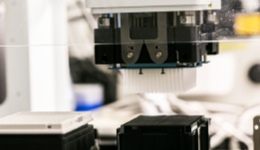-
University Guide
 University Guide
University Guide
INDEX- Introducing the President
- University Introduction
- University Evaluation
-
Policies and Initiatives
- Policy and Initiatives INDEX
- Compliance
- Crisis Management System
- Promoting gender equality
- International Exchange Policy
- Infrastructure longevity plan (individual construction plan)
- Environmental Initiatives
- Smoking is prohibited throughout the university grounds.
- Safety Management Action Plan
- JABEE Initiatives
- Basic rules regarding drinking among Muroran Institute of Technology students
- Policy for promoting the sharing of research facilities and equipment at Muroran Institute of Technology
- Campus Master Plan
- Muroran Institute of Technology Conflict of Interest Management Policy
- Digital Campus Promotion
- Muroran Institute of Technology Open Access Policy
- Muroran Institute of Technology Research Data Policy
-
Information Disclosure
- Information Disclosure INDEX
- Disclosure of corporate information (information about the organization)
- Disclosure of corporate information (information regarding business)
- Disclosure of corporate information (financial information)
- Publication of corporate information (evaluation information)
- Disclosure of corporate information (audit information)
- Publication of educational information
- Compliance status with the National University Corporation Governance Code
- Rules
- Information Disclosure System
- Personal Information Protection System
- Publication of guidelines for employees regarding the promotion of the elimination of discrimination against people with disabilities
- Announcement of the New Support System for Higher Education
- Application and recruitment information
- public relations
-
Faculty/Graduate School/Center etc.
 Faculty/Graduate School/Center etc.
Faculty/Graduate School/Center etc.
INDEX- Faculty of Science and Engineering
- graduate school
-
Affiliated facilities (centers, etc.)
- Affiliated Facilities (Centers, etc.) INDEX
- Creative Collaboration Center
- Aerospace Plane Research Center
- Rare Earth Materials Research Center
- Computer Science Center
- Research Infrastructure Equipment Sharing Center
- Technology Department
- Career Support Center
- International Exchange Center
- Information Education Center
- Affiliated Library
- Health Management Center
- Gender Equality Promotion Office
- MONO Creation Future Co-Creation Organization
- Regional Collaboration Human Resources Development Center
- Manufacturing Infrastructure Center
- Robot Arena
- satellite
- Tokyo Office
- the study
-
Student Life/Employment
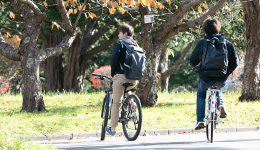 Student Life/Employment
Student Life/Employment
INDEX-
Courses and classes
- Course/Class INDEX
- Academic Calendar
- Lesson plan (syllabus)
- Classes (timetable)
- Exam (timetable)
- Course Affiliation
- Credit transfer with other universities
- Re-reading of course subjects
- CAMPUS SQUARE (Course registration)
- How to take the course
- Student Handbook/Graduate School Course Guidelines
- Transfer of departments, etc.
- Doctoral Degree Application Guide
- Academic Counseling and Guidance
- Duration of study
- Long-term student system
- Educational Programs (not required for graduation or completion)
- A Note About Generative AI
-
Student Life
- Student Life INDEX
- Suspension and Absence
- Various notification and certificate issuance procedures
- Student ID and student number
- Student discount card/school attendance certificate
- Procedures for taking a leave of absence, reinstating, and withdrawing from school
- New academic year orientation
- Preserving the on-site environment
- Attention students
- Transportation on and off campus
- Message board/contact method
- Harassment
- health care
- Events
- Welfare facilities
- Student Dormitory
- Student Support Center Introduction
- Student General Advice Office
- Extracurricular Activities
- Tuition, scholarships and other procedures
- Employment and qualification support
-
Courses and classes
-
Entrance Examination Information
 Entrance Examination Information
Entrance Examination Information
INDEX- University Entrance Examination [Faculty]
- Graduate School Entrance Examination
- Transfer Admissions
- Entrance examination for international students
- Specialized students and research students
- Admission procedures, tuition fees, etc.
- FAQ
- University Introduction
- Request information

-
Social Cooperation
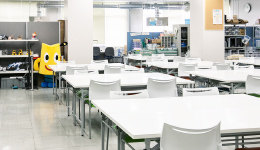 Social Cooperation
Social Cooperation
INDEX- Collaborative News
- Collaboration Centers, etc.
-
Industry-academia-government collaboration
- Industry-academia-government collaboration INDEX
- Alliance Lab
- Research Collaboration Association
- Muro Institute of Technology venture title
- Confidentiality
- Joint Research System
- Commissioned Research System
- Academic Guidance System
- Tangible research results
- Scholarship and Donation System
- Donation field etc.
- Future Creation Promotion Expenses
- Regarding the expenditure of personnel expenses of the principal investigator (PI) from direct costs of competitive research grants
- Research ethics and safety
- Public Lectures
- Muro Institute of Technology Science School
- University Visit
- Robot Soccer Contest
- Re-education for working adults
-
International Exchange
 International Exchange
International Exchange
INDEX- International Academic Exchange Agreements
- Number of international students
- Researcher Database
- Entrance Exam
- Tuition Fees
- International Student Support (for new students)
-
Support for international students (for current students)
- Scholarships for International Students
- Japanese Language Course for International Students
- Immigration procedures (renewal of period of stay, permission to engage in activities other than those permitted under the status of residence, re-entry permission)
- Procedures after arriving in Japan
- Procedures for changing address (under construction)
- Procedures upon returning to Japan
- Notification of absence due to temporary return to Japan, travel, etc.
- Employment for international students
- Emergency Contact Information
- Studying abroad from Muro Institute of Technology
- Request for donations
-
University Guide
University Guide INDEX
- Introducing the President
- University Introduction
- University Evaluation
-
Policies and Initiatives
- Policy and Initiatives INDEX
- Compliance
- Crisis Management System
- Promoting gender equality
- International Exchange Policy
- Infrastructure longevity plan (individual construction plan)
- Environmental Initiatives
- Smoking is prohibited throughout the university grounds.
- Safety Management Action Plan
- JABEE Initiatives
- Basic rules regarding drinking among Muroran Institute of Technology students
- Policy for promoting the sharing of research facilities and equipment at Muroran Institute of Technology
- Campus Master Plan
- Muroran Institute of Technology Conflict of Interest Management Policy
- Digital Campus Promotion
- Muroran Institute of Technology Open Access Policy
- Muroran Institute of Technology Research Data Policy
-
Information Disclosure
- Information Disclosure INDEX
- Disclosure of corporate information (information about the organization)
- Disclosure of corporate information (information regarding business)
- Disclosure of corporate information (financial information)
- Publication of corporate information (evaluation information)
- Disclosure of corporate information (audit information)
- Publication of educational information
- Compliance status with the National University Corporation Governance Code
- Rules
- Information Disclosure System
- Personal Information Protection System
- Publication of guidelines for employees regarding the promotion of the elimination of discrimination against people with disabilities
- Announcement of the New Support System for Higher Education
- Application and recruitment information
- public relations
-
Faculty/Graduate School/Center etc.
Faculty/Graduate School/Center etc. INDEX
- Faculty of Science and Engineering
- graduate school
-
Affiliated facilities (centers, etc.)
- Affiliated Facilities (Centers, etc.) INDEX
- Creative Collaboration Center
- Aerospace Plane Research Center
- Rare Earth Materials Research Center
- Computer Science Center
- Research Infrastructure Equipment Sharing Center
- Technology Department
- Career Support Center
- International Exchange Center
- Information Education Center
- Affiliated Library
- Health Management Center
- Gender Equality Promotion Office
- MONO Creation Future Co-Creation Organization
- Regional Collaboration Human Resources Development Center
- Manufacturing Infrastructure Center
- Robot Arena
- satellite
- Tokyo Office
- the study
-
Student Life/Employment
Student Life/Employment INDEX
-
Courses and classes
- Course/Class INDEX
- Academic Calendar
- Lesson plan (syllabus)
- Classes (timetable)
- Exam (timetable)
- Course Affiliation
- Credit transfer with other universities
- Re-reading of course subjects
- CAMPUS SQUARE (Course registration)
- How to take the course
- Student Handbook/Graduate School Course Guidelines
- Transfer of departments, etc.
- Doctoral Degree Application Guide
- Academic Counseling and Guidance
- Duration of study
- Long-term student system
- Educational Programs (not required for graduation or completion)
- A Note About Generative AI
-
Student Life
- Student Life INDEX
- Suspension and Absence
- Various notification and certificate issuance procedures
- Student ID and student number
- Student discount card/school attendance certificate
- Procedures for taking a leave of absence, reinstating, and withdrawing from school
- New academic year orientation
- Preserving the on-site environment
- Attention students
- Transportation on and off campus
- Message board/contact method
- Harassment
- health care
- Events
- Welfare facilities
- Student Dormitory
- Student Support Center Introduction
- Student General Advice Office
- Extracurricular Activities
- Tuition, scholarships and other procedures
- Employment and qualification support
-
Courses and classes
- Entrance Examination Information
-
Social Cooperation
Social Collaboration INDEX
- Collaborative News
- Collaboration Centers, etc.
-
Industry-academia-government collaboration
- Industry-academia-government collaboration INDEX
- Alliance Lab
- Research Collaboration Association
- Muro Institute of Technology venture title
- Confidentiality
- Joint Research System
- Commissioned Research System
- Academic Guidance System
- Tangible research results
- Scholarship and Donation System
- Donation field etc.
- Future Creation Promotion Expenses
- Regarding the expenditure of personnel expenses of the principal investigator (PI) from direct costs of competitive research grants
- Research ethics and safety
- Public Lectures
- Muro Institute of Technology Science School
- University Visit
- Robot Soccer Contest
- Re-education for working adults
-
International Exchange
International Exchange Index
- International Academic Exchange Agreements
- Number of international students
- Researcher Database
- Entrance Exam
- Tuition Fees
- International Student Support (for new students)
-
Support for international students (for current students)
- Scholarships for International Students
- Japanese Language Course for International Students
- Immigration procedures (renewal of period of stay, permission to engage in activities other than those permitted under the status of residence, re-entry permission)
- Procedures after arriving in Japan
- Procedures for changing address (under construction)
- Procedures upon returning to Japan
- Notification of absence due to temporary return to Japan, travel, etc.
- Employment for international students
- Emergency Contact Information
- Studying abroad from Muro Institute of Technology
- Request for donations
- HOME
- Faculty/Graduate School/Center etc.
- Faculty of Science and Engineering
- Department of Creative Engineering
- Aerospace Engineering Course
Aerospace Engineering Course

I want to fly an airplane with my own hands! I want to learn about the mechanisms of aircraft and rockets!
After learning the fundamentals of flight mechanics, propulsion engineering, structural engineering, and other fields required for the design and operation of aircraft, rockets, and artificial satellites, students gain practical experience in systems-oriented aerospace engineering.
About the Education Program
Systematically acquire elemental technologies and develop practical system design skills
From the first year to the first half of the second year, students take general education subjects, faculty and department-wide (natural science) subjects, and some information-related subjects to acquire communication skills and social literacy, as well as basic specialized subjects in related fields (basics of flow, thermodynamics, material mechanics, electrical circuits, measurement engineering, etc.). From the second half of the second year onwards, students are assigned to this course, where they systematically learn elemental technologies such as aerodynamics, aircraft structure and materials, guidance and control, propulsion engineering, and electrical and electronic engineering, and also practically study a specialized aerospace curriculum centered on system design skills.

Aerospace Engineering Course
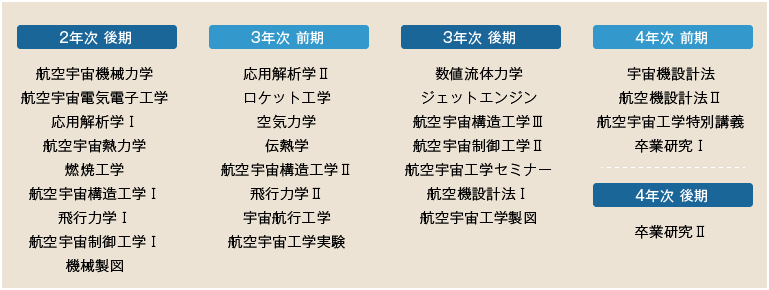
Flow of the four years
First year
Students will develop the fundamentals of science and engineering by studying general education subjects such as "human and society-related subjects," "foreign language subjects," and "regional collaboration subjects," common natural science subjects such as "mathematics," "physics," "chemistry," and "biology," and information-related subjects such as "Introduction to information security," "Introduction to data science," and "Introduction to programming."
Second Year
In the first semester of the second year, students will study a range of subjects across fields, including "Mechanics of Materials," "Mechanics of Flow," "Basic Thermodynamics," "Basic Electromagnetism," "Basic Electrical Circuits," and "Measurement Engineering," to acquire the basic knowledge required for studying specialized subjects. They will also acquire data utilization skills through information subjects such as "Introduction to Modern Informatics," "Probability and Statistics," and "Statistical Data Processing." From the second semester of the second year, students will be assigned to this course and will study specialized course subjects such as "Aerospace Mechanical Mechanics," "Combustion Engineering," and "Flight Mechanics."
3rd year to early 4th year
From the second semester of the second year, students continue to acquire specialized knowledge that is the foundation of aerospace engineering through course subjects such as "Aerodynamics," "Rocket Engineering," "Jet Engines," and "Astronautics," while also acquiring system-oriented practical application skills through practical subjects such as "Aircraft Design I," "Aircraft Design II," and "Spacecraft Design."
Fourth Year
In the fourth year, students are assigned to a research lab and engage in practical learning through graduation research. They set goals for issues in their respective fields, tackle them using the knowledge and skills they have acquired, and by achieving their goals, they solidify their knowledge and develop problem-solving skills.
Aerospace Engineering Course Pickup
About the classes
Aircraft Design Method I & II
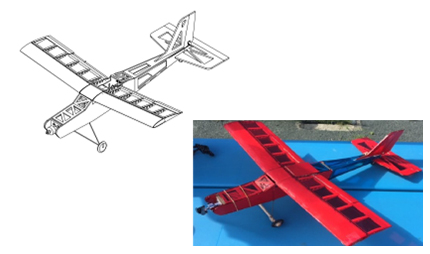
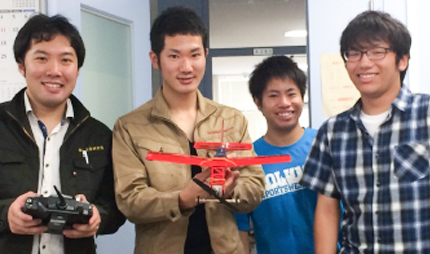
In "Aircraft Design Method I" in the second semester of the third year, students design a radio-controlled, motor-propelled model airplane as a culmination of the specialized knowledge and skills they have learned up to that point, such as aerodynamics, flight mechanics, and drafting. In "Aircraft Design Method II" in the first semester of the fourth year, students actually build and fly the airplane, and finally present the results in front of everyone. Through this kind of practical learning, students will fully acquire the knowledge they need to be successful as engineers in the field of aerospace engineering.
About the Research
Research to revolutionize high-speed flight systems into the atmosphere and into space
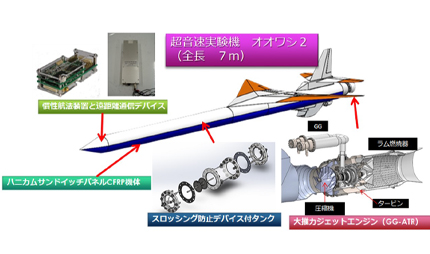
In collaboration with the Aerospace Plane Research Center, we are researching and developing a small supersonic flight experimental aircraft (Oowashi). We are developing the following: 1) a lightweight, high-strength, high-rigidity, and high-performance aircraft that uses a lot of composite materials, 2) an aircraft with high flight characteristics that realizes stable flight from subsonic to supersonic speeds, 3) a high-performance propulsion system that realizes supersonic flight, and 4) a guidance, control, and communication system that realizes autonomous flight. These research and development projects are carried out by undergraduate students assigned to the Aerospace Plane Research Center as part of their graduation research, under the guidance of faculty and graduate students.
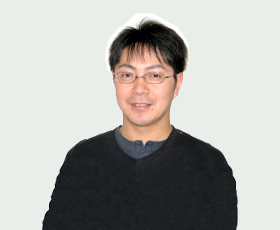
Professor Masaharu Utsumi
Director, Aerospace Plane Research Center
Research Field
Aerospace Systems Engineering, Rocket Propulsion Engineering
Main research themes
Development of elemental and system technologies for supersonic jet and rocket engines
Licenses and qualifications available
driver licence
- High school teacher license (industrial) etc. *Teacher training course credits required
Employment situation
- All Nippon Airways
- DOWA Holdings
- IHI
- JFE Plant Engineering
- Hokkaido Railway Company
- NOK
- Isuzu Motors
- AIRDO
- Kubota
- Kobelco Construction Machinery
- Suzuki
- Nabtesco
- Ebara Corporation
- Japan Maritime Self-Defense Force
- Tsukishima Machinery
- Furukawa Co., Ltd.
- Japan Air Self-Defense Force
- Takasago Thermal Engineering
- Mitsubishi Motors
- Mitsubishi Electric Engineering
- Sumitomo Heavy Industries
- Nippon Steel Corporation
- Shinryo Corporation
- Kawasaki Heavy Industries
- Kawaju Gifu Engineering
- Obayashi Corporation
- Central Engineering
- Churyo Engineering
- Tokyo Fire Department
- Nippon Steel Tex Engineering
- Nippon Express
- Japanese Airplane
- Hitachi Automotive Systems
- Hitachi Industrial Equipment Systems
- Hitachi Zosen
- Ryoyu Systems, etc.

